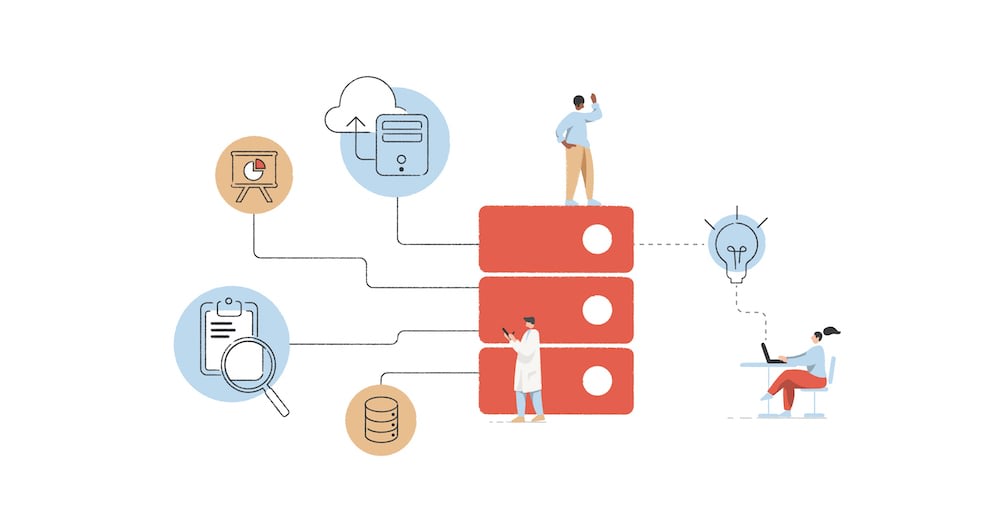Data
Apr 29, 2021
Understanding data and analytics maturity: A focus on Data Services and final reflections

In previous articles, we have touched on a number of trends affecting the basic assumptions of why data exists, how it should be stored and used, and how teams are organised to deliver value from it. We have summarised these points below.

Firstly, open data will transform the innovative potential of data. Organisations are being encouraged to share their data for national and international benefit and to allow business leaders to reimagine business processes through access to data & analytics. In a recent webinar on how to enable and incentivise open data, we explored how organisations can prepare for this trend by providing technical and service enablers, instituting data marketplaces, adopting automated data management such as AI, and by moving to revised security and privacy models.
Secondly, the advent of the data mesh will fundamentally change the nature of enterprise data architecture. Organisations are beginning to move away from centralised monoliths such as the data lake and more towards distributed data architectures, where business-led teams are empowered to deliver end-to-end solutions and data is treated as a product (not tied to a strategic monolith like a data warehouse) managed on accessible cloud infrastructure and services.
In addition, existing data platforms will need to be uplifted. This will enable greater access, interoperability, and innovation through the adoption of micro-services, serverless architectures, and modern data processing mechanisms (such as streaming) and allow data to travel more freely.
Finally, delivery mechanisms are also changing as a result of these developments. Easily procurable cloud services and access to data make interaction with the CIO or CDO office less necessary, and the move towards Agile, DevOps and DataOps practices results in greater delivery federation.
Data management services
In our view, existing data management practices and approaches need to be reimagined to reflect the need to deliver actionable analytics at pace. This needs to be done in a way that reflects how modern businesses deliver complex analytical solutions. In short, data management needs to go Agile.
In our previous article, we discussed how to operationalise 'Data Governance as an enabler.' We believe that this shift from more traditional approaches to Agile, delivery focused models of data management is crucial in ensuring that the organisation matures in a way that reflects modern trends in data architecture.
Data management needs to be reimagined as a model of ‘shared responsibilities’, where key aspects of the DAMA DMBoK Framework are achieved through the shared execution of responsibilities across delivery and capability , under the supervision of the offices of the CDO and CIO respectively.
This will require the creation of data management services that support business-led delivery as well as the embedding of new ways of working. It is therefore important to develop strong data practices and communities under the leadership of the CDO, combining deep knowledge of data management with service design and delivery expertise.
Continuous data improvement
To implement widespread and continuous data management, we recommend that organisations familiarise themselves with leading frameworks such as DAMA’s DMBoK in order to understand the main aspects of data management and the techniques used to achieve them. These aspects might include:
Data Management Strategy: A coherent vision, guiding principles, and operating model are required, combined with clear governance structures with roles & responsibilities for data.
Data Governance: Ensure that all data sources have an ownership and accountability structure tied to the organisation’s set-up to enable policy enforcement and monitoring.
Data Architecture: Align the enterprise’s data architecture with the data strategy to ensure that data management can be fully operationalised through solution designs.
Data Quality: Apply data quality dimensions to critical data assets to enhance data quality through effectively designed rules and an agreed issue management processes.
Master & Reference Data: Master data assets and implement controls to increase the understanding of data and to reduce the number and scale of data related challenges.
Metadata Management: Manage metadata related to models, lineage, catalogues, and glossaries to improve user confidence in data and prevent incorrect usage of data.
Control Environments: Link back to governance and ensure that data management is supported by a proper set of controls that operationalise rules in the context of the organisation’s risk management framework and its ‘lines of defence’ control model.
Cultural Change: Increase data literacy and ethical practices by actively affecting the organisation’s culture, as well as creating data management practices and policies.
Not only will understanding and implementing data management allow you to provide the services that the business needs to operationalise AI & Machine learning applications, but it will also help you navigate constantly changing regulatory requirements beyond the likes of GDPR and BCBS-239.
In particular, data ethics is increasingly in the spotlight and there is more regulatory restrictions as a result. It is therefore important to prepare your organisation for stricter rules and frameworks in future and mitigate any ethical risks as part of the organisation’s approach to data management.
Key takeaways
Numerous trends in data & analytics - both internal and external - are increasing the need for a service-orientated approach to data management, providing business-led teams with the support and guidance they need to deliver solutions independently and at greater scale.
It is crucial that organisations operationalise data management through collaborative and Agile forms of Data Governance, whilst shaping the organisation around a ‘shared responsibility’ model for the execution of data management responsibilities.
Establishing widespread and continuous data improvement requires that the organisation understand and implement data management capabilities. We recommend that organisations use leading frameworks such as DAMA DMBoK as an effective starting point.
Final thoughts on data & analytics maturity
We hope that this series of articles has helped readers to understand why a structured approach to assessing data & analytics maturity is crucial to transforming the ability to use critical data assets.
Although increasing maturity is a long-term process, it is important to start by contextualising what ‘maturity’ means within a specific programme. They should then plan how to improve across the most important and impactful aspects in a co-ordinated fashion, reviewing and optimising at each stage.
Organisations will also see that the expected benefits of greater maturity can translate directly to business outcomes, iteratively re-running a maturity assessment to provide regular benchmarking. Design with the end in mind and carefully consider how to measure and demonstrate ROI, including any non-financial impacts, to senior stakeholders and end users (using the maturity model as a basis).
Finally, use the concept of maturity to help your organisation understand which capabilities and changes are required to leverage new trends like open data, the data mesh, and data marketplaces. Do this in the context of the use cases and outcomes that your stakeholders care most deeply about.
If you have any questions relating to the topics discussed in this blog or would like us to help you assess your data maturity, please get in touch with one of our experts.
Contact Us
Let's talk!
We're ready to help turn your biggest challenges into your biggest advantages.
Searching for a new career?
View job openings